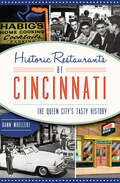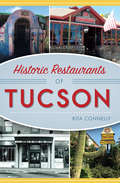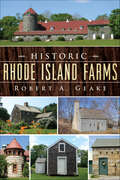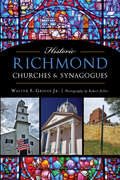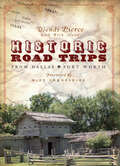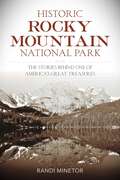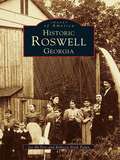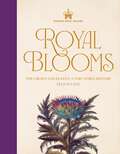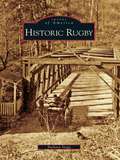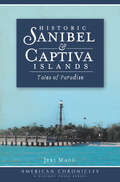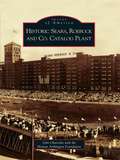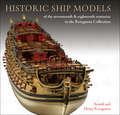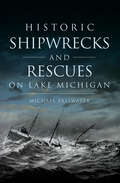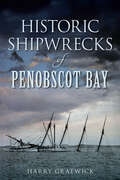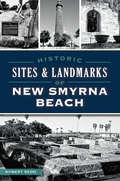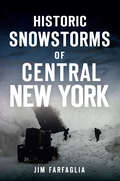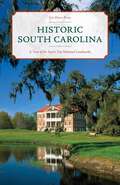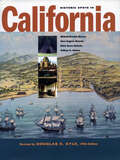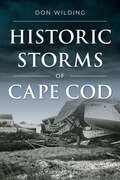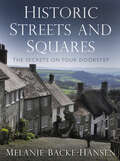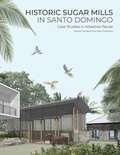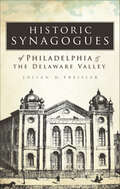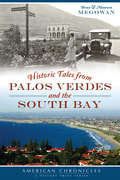- Table View
- List View
Historic Restaurants of Cincinatti: The Queens City's Tasty History (American Palate Ser.)
by Dann WoellertA Cincinnati food writer shares a fascinating and fully illustrated homage to the Ohio City&’s culinary history and most beloved eateries. Cincinnati is the home to food innovations, rivalries and restaurants that stand the test of time. The Queen City boasts the invention of both Cincinnati chili and goetta, the beloved breakfast meat. Legendary establishments like Mecklenburg Gardens, Arnold&’s, Izzy&’s and Scotti's have all operated for over a century. The French restaurant Maisonette was the epitome of fine dining, and Wong Yie&’s Famous Restaurant elevated America&’s Chinese cuisine from street fare to an exotic experience. Busken Bakery and Frisch's vied for Cincinnati pumpkin pie supremacy by taking digs at each other through billboards and redecorating a Big Boy statue in Busken attire. Author Dann Woellert explores the most iconic eateries, the German influence on Queen City food and what makes dining so unique in Cincinnati.
Historic Restaurants of Tucson (American Palate)
by Rita ConnellyTucson's culinary journey began thousands of years ago, when Native American tribes developed an agricultural base along the Santa Cruz River. In modern times, restaurants ranging from tiny taquerias to fine dining spaces all contributed to the local food culture. El Charro, serving Mexican cuisine since 1922, still attracts crowds from all over. Folks head straight to Pat's for a hot dog, Lucky Wishbone for some fried chicken or eegee's for a grinder and a cold, frosty drink. On any given night, the patio at El Corral is filled with diners anticipating their famous prime rib and tamale pie. Local food writer Rita Connelly brings to life the stories of beloved eateries that have endured for decades and continue to delight with incredible flavors.
Historic Restaurants of Washington, D.C.: Capital Eats (American Palate Ser.)
by John DeFerrariDiscover the culinary heritage of America&’s capitol with this guide to Washington, D.C.&’s historic restaurants and storied local eateries. While today&’s foodies enjoy the latest culinary trends of Logan Circle and the H Street corridor, Washington's first true restaurants opened around 1830. Waves of immigrants introduced a global mix of ingredients to the capital&’s eager palates by opening eateries like the venerable China Doll Gourmet and Cleveland Park's Roma Restaurant. By the twentieth century, the variety and quality of cuisine was astounding. Diners could have tea at Garfinckel's Greenbrier or lunch at local favorites such as Little Tavern Diner or Ben's Chili Bowl. For an elegant evening, fine restaurants like Rive Gauche and the Monocle satisfied the most sophisticated gastronome. With careful research and choice recipes, &“Streets of Washington&” blogger John DeFerrari chronicles the culinary and social history of the capital through its restaurants, tasting his way from the lavish Gilded Age dining halls of the Willard Hotel to the Hot Shoppe's triple-decker Mighty Mo.
Historic Rhode Island Farms (Landmarks)
by Robert A. GeakeDating back to the colonial era, the historic barns and outbuildings of Rhode Island have withstood the test of time. From the state's early barnyard taverns to the modern-day horse and dairy farms that populate rural Rhode Island, each of these buildings has a story to tell. In the mid-eighteenth century, the Narragansett planters bred horses on their farms in southern Rhode Island. Later, dairy farms sprang up across the region. Milking barns were built on the largest farms in the state, including the Theinhert Dairy Farm and Barn in Lincoln. Before the advent of electric trolleys, urban barns sheltered horses for early tramcar transportation. Each barn is a beloved reminder of the state's history. Join author Robert A. Geake as he explores the origins and evolution of Rhode Island's farms.
Historic Richmond Churches & Synagogues
by Walter S. Griggs Jr. Robert DillerRichmond’s historic houses of worship cannot be separated from the city’s storied past. A young Patrick Henry sparked a revolution with his “Give Me Liberty or Give Me Death” speech inside St. John’s Episcopal Church on Church Hill. Congregation Beth Ahabah, with its awe-inspiring windows and adjoining museum, is one of the oldest and most revered synagogues in the country. An interstate highway was moved to save the Sixth Mount Zion Baptist Church, where John Jasper asserted, “De Sun do move,” in the most famous sermon ever preached in the city. Beloved local author Walter Griggs Jr. tells the compelling history of Richmond’s most holy places.
Historic Road Trips from Dallas/Fort Worth
by Wendi PierceRick Steed and his driving companion, Wendi Pierce, set off with one goal in mind: to travel Texas's old fort trails and scout today's remnants of the bloody skirmishes and battles of long ago. Historic Road Trips from Dallas/Fort Worth provides not only a road map of day trips throughout Texas but also a narrative history of the tiny towns, historic markers and frontier excitement along the way. After collecting these stories for years, Steed teamed up with Pierce to bring to life this fascinating guidebook for anyone who yearns to venture off the main road and discover old Texas. Each drive begins in the Dallas/Fort Worth area and travels a different route through the state. Travel along and discover the site of Buffalo Hump's revenge raid or Cynthia Ann Parker's harrowing pioneer experiences, as well as other local lore, including the haunting of Jefferson, Texas's Jefferson Hotel, the notorious New London school accident and much, much more.
Historic Rocky Mountain National Park: The Stories Behind One of America's Great Treasures
by Randi MinetorHistoric Rocky Mountain National Park captures fascinating moments and untold stories in the history of this magnificent national park, from the days when Paleo-Indians roamed between the mountain peaks to the settlement of the valleys by ranchers and hoteliers. Stories of the Ute and Arapaho tribes, the 1859 Gold Rush, the first people to summit 14,259-foot-high Long's Peak, the women who climbed to the top of the Rockies, the fossils revealed by snowfield melt, the advocates who worked to protect this landscape, and more provide just enough history to make your visit to the top of America even more exciting than you anticipated.
Historic Roswell Georgia: Georgia (Images of America)
by Rebecca Nash Paden Joe MctyreIn the 1830s and 1840s, low country planters came to Roswell, Georgia, seeking relief from the heat and malaria that plagued Georgia's golden coast. The wealthy plantation owners were attracted to the temperate North Georgia climate by Roswell King-a former Glynn County plantation supervisor, builder, and entrepreneur-who promised his friends free land on which to build their homes and stock in the textile mill he built in 1839. The village of Roswell was laid out in 1840 with wide streets, a park, mills, and a residential area, and a community founded by devout Presbyterians and hard-working industrialists began to take shape. By the onset of the Civil War, Roswell had two cotton mills, a woolen mill, and flour and grist mills nearby. The town's strategic location near the Chattahoochee River made it a target of Union Gen. William T. Sherman during his March to the Sea in 1864. While Federal soldiers occupied Roswell that summer, none of the grand homes of the town were destroyed. Residents persevered the tolls of war and Reconstruction to rebuild mills and strengthen the local economy. A small and rural community through the early part of the 20th century, Roswell experienced phenomenal growth in the latter half of the century to become a bustling Atlanta suburb; yet much of the charm and small-town character remains and thousands of tourists are attracted each year by its beautiful antebellum homes and buildings. These treasured landmarks are the subject of this engaging retrospective, and each snapshot glimpse will illuminate the Roswell of yesteryear.
Historic Royal Palaces: The Crown and Plants: A Very Noble History (Historic Royal Palaces)
by Felicity DayHistoric Royal Palaces: Royal Blooms is a fascinating exploration of how plants and flowers have formed an integral part of the crown, from the past through to present day. From mulberry and myrtle to pomegranate and poppy, this beautifully illustrated and expertly written book depicts in detail how plants and flowers have been used by various royals throughout the centuries not just for power, politics and status but more recently, celebration. This four-colour beautiful, upmarket gift book is filled with interesting facts and captivating stories alongside stunning botanical illustrations and historical photographs from the Historic Royal Palaces archive, all focused on the crown's fascination with plants and flowers, from the war of the roses to royal wedding bouquets and everything in between.
Historic Royal Palaces: The Crown and Plants: A Very Noble History (Historic Royal Palaces)
by Felicity DayHistoric Royal Palaces: Royal Blooms is a fascinating exploration of how plants and flowers have formed an integral part of the crown, from the past through to present day. From mulberry and myrtle to pomegranate and poppy, this beautifully illustrated and expertly written book depicts in detail how plants and flowers have been used by various royals throughout the centuries not just for power, politics and status but more recently, celebration. This four-colour beautiful, upmarket gift book is filled with interesting facts and captivating stories alongside stunning botanical illustrations and historical photographs from the Historic Royal Palaces archive, all focused on the crown's fascination with plants and flowers, from the war of the roses to royal wedding bouquets and everything in between.
Historic Rugby
by Barbara StaggThe Rugby colony opened amid great fanfare in 1880 on East Tennessee's sparsely settled and rugged Cumberland Plateau. Famous British author and social reformer Thomas Hughes was the most involved and dedicated of Rugby's Anglo-American founders. He intended Rugby to be a class-free, agrarian community based on cooperative enterprise, culture, and religious freedom. During its first decade, hundreds immigrated to Rugby from the British Isles; hundreds more came from other parts of America. Some stayed briefly, some for years, some for life. More than 60 cottages, villas, and commercial and institutional buildings of distinctive Victorian styles were built during Rugby's early years. Though Rugby was briefly the most thriving community on the northern plateau, many factors prevented realization of Hughes's utopian goals. Rugby today is a rare surviving example of 19th-century utopian community building. The historic town plan, surrounding woodland and rivers, and key original buildings survive, unspoiled by modern development, through committed restoration and preservation. Heritage tourism is bringing new life.
Historic Sanibel & Captiva Islands: Tales of Paradise
by Jeri MaggThe story of Sanibel and Captiva Islands stretches back over three hundred years, to a time when natives roamed the islands and Spanish explorer Ponce de Leon first met and tried to subdue the Calusa Indians in San Carlos Bay in 1513. The next few centuries were flooded with pioneers, fishermen and clergymen in their quest to tame the wilderness in search of a better life. Discover how anthropologist Frank Cushing visited pioneer Sam Ellis in 1895 after the farmer discovered bones on his homestead and how President Theodore Roosevelt's men saved a little girl from drowning when he lived on a houseboat in Captiva to study local marine life. Join local history columnist Jeri Magg as she recounts the storied history of these little slices of paradise.
Historic Sears, Roebuck and Co. Catalog Plant
by John Oharenko Homan Arthington FoundationLocated on the site of the original Sears Tower, the historic Sears, Roebuck and Company catalog plant is one of the nation's most unique landmarks. Representing American ingenuity at its best, Richard Sears and Julius Rosenwald combined technology, commerce, and social science with bricks and mortar to build "the World's Largest Store" on Chicago's West Side. Completed in 1906, the plant housed nearly every conceivable product of the time: clothing, jewelry, furniture, appliances, tools, and more. The complex employed 20,000 people, and merchandise orders were processed and delivered by rail--within the same day. During the first two decades of the 20th century, almost half of America's families shopped the over 300 million catalogs published in that era. WLS (World's Largest Store) Radio broadcasted the Gene Autrey show from the top of the tower, and the first Sears retail store opened here on Homan Avenue and Arthington Street. In 1974, Sears moved to the current Sears Tower. Thanks to many individuals who fought to save these architecturally and historically important treasures, the administration building, the original Sears Tower, the catalog press-laboratory building, and the powerhouse remain today. There are currently plans for redeveloping these buildings into housing, office, and retail space. A new Homan Square Community Center stands on the site of the merchandise building.
Historic Ship Models: of the seventeenth & eighteenth centuries in the Kriegstein Collection
by Arnold Kriegstein Henry KriegsteinIn terms of quality, historical significance and sheer numbers, the Kriegstein family’s ship model collection in the United States is the finest in private hands anywhere in the world. Principally made up of official 17th- and 18th-century models in the Admiralty or Navy Board style, the collection is unrivalled by any museum outside the British national collection at Greenwich. As the models are not on public display, this book fills the need for a detailed catalogue and visual reference with superb colour photos of all the models, both overall portraits and multiple close-ups. Apart from lengthy descriptions of these magnificent artefacts, space is devoted to how they were identified, and the valuable research done by Arnold and Henry Kriegstein, the identical twins whose shared passion brought this all together. Beyond the technicalities of the ships, the story has a human dimension in the brothers’ adventures in pursuit of every model and their dogged determination to secure them against official obstruction and dubious antiques-trade practices. This is an entirely new and revised edition of Seventeenth and Eighteenth Century Ship Models first published in 2007, now expanded to include the additions to the collection since that date.
Historic Shipwrecks and Rescues on Lake Michigan (Disaster)
by Michael PasswaterFacing the fury and danger of Lake MichiganEver since French explorers first cast their eyes on Lake Michigan, this huge inland sea has been the scene of thousands of shipwreck rescues and tragedies. As mishaps and disasters proliferated, a dedicated service of lifesavers arose. Braving perilous conditions, these servicemen pulled those aboard the merchant schooner Havanna from certain death. The intrepid St Joseph Lifesavers saved the crew and passengers of the City of Duluth. Sadly, not all rescues ended in heroism, as was the case with the doomed Arab that went down along with two other ships. Author Michael Passwater captures the stories of shipwrecks and the brave men and women that risked their lives against an angry Lake Michigan.
Historic Shipwrecks of Penobscot Bay (Disaster Ser.)
by Harry GratwickAn in-depth history of the Maine inlet&’s most historic and dramatic shipwrecks. Thousands flock to the beautiful coastline along Penobscot Bay every year, but the dark sea has often turned treacherous. Temperamental skies become stormy without notice; violent gales challenge even the most seasoned captains. Craggy rocks can be virtually invisible to oncoming vessels, like the Alice E. Clark, which simply strayed off course in good weather. Other ships, like the Governor Bodwell and Royal Tar, were destroyed by fire. But not all the ships were a total loss—some were repaired and resumed life under different names. Local author Harry Gratwick explores some of Penobscot Bay&’s most historic and dramatic shipwrecks, from what caused the wrecks to what happened during those fateful moments when the ships were going down.
Historic Sites & Landmarks of New Smyrna Beach (Landmarks)
by Robert ReddNew Smyrna Beach is the third-oldest city in Florida behind only St. Augustine and Pensacola. Originally settled by Dr. Andrew Turnbull in 1768, the city accumulated significant, intriguing and stunning monuments to its past. An unusual-looking memorial to world war heroes--a cross, battle helmet and eagle--sits at Riverside Park. One of the oddest sites is a single-stone cemetery with a vault dedicated to the memory of Charles Dummett. Because of the insects that inhabit Ponce Inlet, a well-known landmark was originally named Mosquito Inlet Lighthouse. Local author and historian Robert Redd guides readers through the iconic historical landmarks of "Florida's Secret Pearl."
Historic Snowstorms of Central New York (Disaster)
by Jim FarfagliaCentral New York, a region renowned as one of the snowiest in the world, has a long and stormy relationship with its winters. From the Lake Ontario port in Oswego to the busy streets of Syracuse and Utica, every community in the region has found themselves buried from brutal snowstorms. Author Jim Fafaglia draws from personal memories, family diaries and newspaper accounts to craft a two-hundred year history of Central New York's whiteouts, blizzards and snowstorms.
Historic South Carolina: A Tour of the State's Top National Landmarks
by Lee Davis PerryHistoric South Carolina: A Tour of the State's Top National Landmarks is a carefully curated travel guide, written by a local historian, featuring the most intriguing and significant of the state's nationally recognized historic landmarks. This guide provides interesting anecdotes and color photography of famous manors and plantation houses, centuries-old churches and chapels, and beautiful marshlands of the Low Country. Tour the Palmetto State and travel back in time with Historic South Carolina.
Historic Spots in California: Fifth Edition
by Ethel Rensch Douglas Kyle William Abeloe Mildred Hoover Hero RenschThe only complete guide to the historical landmarks of California, this standard work has now been thoroughly revised and updated. The edition is enriched by some 200 photographs, most of which were taken by the reviser and all of which are new to this edition. Since the last revision in 1990, enormous changes have taken place within the state: many landscapes and buildings have been greatly altered and some are no longer in existence. Every effort has been made, through personal observation, to record the present condition of the landmarks and to provide clear and accurate descriptions of their locations. The text is written with the idea that the reader might use the book while traveling around the state, and thus mileage and signposts have been given where it was thought helpful. For this new edition, the reviser has added additional information on the state's geography, the presence of Native Americans, and state and local museums. To provide historical background, the reviser has written a short historical overview. The chapters of the book are organized by county, in alphabetical order. A rough chronology is followed for each county, beginning with pertinent facts on geography, continuing with Native American life, the coming of the Spaniards and other Europeans, the American conquest of the 1840s, and, in those areas where it had a major impact, the gold rush. The text then continues into the period of intensive agricultural development, railroads, industrialization, the growth of cities, the effects of World War II, and on into more recent times. The bibliography, like the text, has been updated to 2001 and includes some of the established classics in California history as well as more recent material. Reviews of the Fourth Edition "Prodigious in detail and scope, this is the definitive guide to historical landmarks in California and a valuable resource not only for travelers but also for anyone interested in California history." --California Highways "This is an outstanding and accessible piece of scholarship, one that every student of California will value." --San Francisco Chronicle "Kyle and Stanford University Press are to be lauded for this monumental undertaking." --Southern California Quarterly
Historic Storms of Cape Cod (Disaster)
by Don WildingCape Cod has always been in the path of deadly hurricanes and ferocious storms. Unwelcome summer visitors include the "Long Island Express" Hurricane of 1938, the Great Atlantic Hurricane of 1944, the twin Hurricanes Carol and Edna in 1954, and Hurricane Bob in 1991. These storms destroyed countless homes and left several coastal communities under several feet of water. Surging tides carried away houses with residents inside who didn't survive and sank the Coast Guard lightship Vineyard in Buzzards Bay, killing all 12 crew members. Fall and winter brought the benchmark Blizzard of 1978, the nor'easter of January 1987, and the infamous "Perfect Storm" of October 1991 which delivered some of the highest tides ever seen on the Outer Cape. Local author Don Wilding revisits the Cape's most severe weather events and their devastating impact.
Historic Streets and Squares: The Secrets On Your Doorstep
by Melanie Backe-HansenIn this picturesque exploration of Britain’s constructed landscape, an array of medieval lanes, Georgian crescents and Victorian squares make an appearance, together with the people – famous, infamous and unfamiliar – who designed, built and lived in them. From Bedford Square and Portobello Road in London, through to Grey Street in Newcastle and Charlotte Square in Edinburgh, Historic Streets and Squares takes you over the doorstep of some of the country’s most familiar addresses.Melanie Backe-Hansen takes us beyond the facades, delving into the evolution of ancient streets, the aspirations of builders and architects, and the extraordinary lives of past residents. She also reveals the fascinating stories of how some of our oldest and most valued crescents, lanes and avenues have survived into the twenty-first century, and the twists and turns of their journey along the way.Taken together, these fifty examples tell us much about Britain’s urban development over the centuries, while also highlighting more recent attempts to preserve our architectural heritage. The history of our streets, avenues, lanes and squares reveals more than just changes to architectural style, but offers a doorway into the heritage of our nation.
Historic Sugar Mills in Santo Domingo: Case Studies in Adaptive Reuse
by Jaime Correa Carmen GuerreroDistributed by University Press of Florida on behalf of the Brian Canin Urban Design AwardColonial sugar mills, ingenios coloniales, are essential to the material history of the Dominican Republic. They served as a cornerstone of the national economy and as a foundation for the stability required during the colonial era. From the 1500s to the end of the 1800s, sugar mills and sugar factories were founded and sustained in what is now known as “La Ruta del Azucar,” or the Sugar Road. Colonial sugar mills not only represent a significant period in the country's history, but they also hold significant cultural and architectural value.In this volume, students at the School of Architecture of the University of Miami explore what is left of some of the most important ingenios coloniales in the Dominican Republic and, through an innovative approach of adaptive reuse, propose alternatives to celebrate their architectural value and cultural influences while also exploring the socio-economic and racial disparities and the political ideologies that are part of the history of these sites. The students approached the project with a spirit of innovation and the desire to document histories and possibilities for future generations in the Dominican Republic and to leave behind a legacy for new students to do similar work in urban and rural environments.
Historic Synagogues of Philadelphia & the Delaware Valley
by Julian H. PreislerIn 1740, Nathan Levy�one of the first Jewish residents ofPhiladelphia�requested a plot of land to give his child a Jewish burial. This plot on Spruce Street became the first Jewish communal cemetery and marked the beginning of organized Jewish life in the colonial city. Throughout the nineteenth and early twentieth centuries, floods of Jewish immigrants came to the United States from Europe and settled in Philadelphia and throughout the Delaware Valley. As a result, hundreds of synagogues were organized and flourished. Today, Philadelphia�s myriad synagogues are like living museums of architectural history. From small wooden structures that evoke Eastern Europe to the sharp angles, modern lines and soaring sanctuary space envisioned by Frank Lloyd Wright, these synagogues reflect changing trends in style, design and function. With this comprehensive collection of images, Preisler helps record the region�s unique religious and cultural history and captures in time its architectural treasures.
Historic Tales from Palos Verdes and the South Bay
by Maureen Megowan Bruce MegowanPalos Verdes and the South Bay's dramatic beauty is mirrored by a dramatic history. Feuding over claims to the Rancho San Pedro continued for seventy-three years. The Vanderlip family's forty-year development of the Palos Verdes Peninsula resulted in one of California's wealthiest and most well-kept enclaves of coastal cities. Marineland of the Pacific on the Peninsula's end was one of the West Coast's more popular tourism draws before its controversial closing. But that's only the beginning. In this exciting compilation of articles, authors Bruce and Maureen Megowan reveal some of the intriguing secrets and little-known facts nestled within the hills, valleys and nearby cities of this beautiful area. Discover some of the fascinating stories about the development of the South Bay and Palos Verdes Peninsula.
